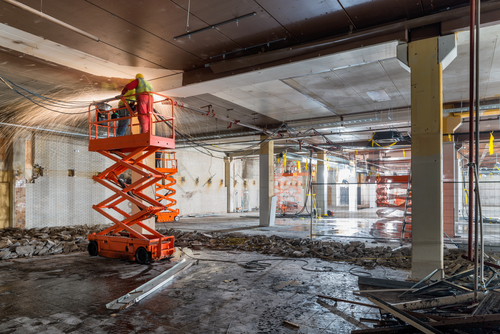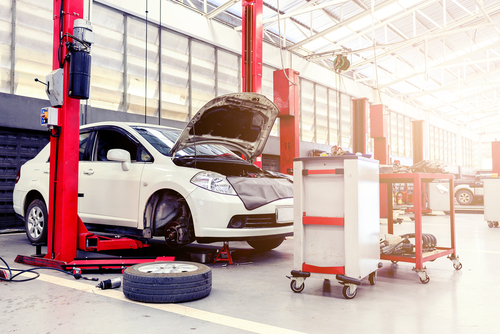
Reducing Lift Downtime: Keeping Lifts Operational for as Long as Possible
November 1, 2023
DIY Lift Maintenance: Pros, Cons, and Safety Precautions
January 30, 2024Hydraulic Lift Maintenance: Specialized Care for Reliable Performance

Hydraulic Lift Maintenance Specialized Care for Reliable Performance
Hydraulic Lift Maintenance: Specialized Care for Reliable Performance. In the world of industrial machinery, hydraulic lifts play an indispensable role in facilitating the movement of heavy loads with precision and safety.
These workhorses find applications across diverse industries, from construction to manufacturing, enabling tasks that would otherwise be labor-intensive and potentially dangerous.
However, the key to their enduring and dependable performance lies in one critical aspect: maintenance. This comprehensive article will delve into the utmost importance of specialized care for hydraulic lifts.
We will explore their underlying systems, the significance of maintenance, and practical maintenance guidelines to ensure their optimal functionality and safety.
The Significance of Hydraulic Lifts
Hydraulic lifts are the backbone of many industries, simplifying tasks that involve the lifting and lowering of substantial objects.
These devices assist daily operations in warehouses, automotive repair shops, or manufacturing facilities. Maintaining these machines to ensure their safety and reliability is paramount.
Maintenance is not merely a reactive measure; it is a proactive strategy to ensure the consistent and safe operation of hydraulic lifts.
Specialized care guarantees that these machines function smoothly, prevent accidents, and extend their operational lifespan.
In this article, we will explore the fundamental principles of hydraulic lift operation and delve into maintenance’s pivotal role.
Understanding Hydraulic Lift Systems
How Hydraulic Lifts Operate
Hydraulic lifts operate on a straightforward yet highly efficient principle: the application of hydraulic pressure to elevate and lower objects.
A pump drives hydraulic fluid into a cylinder, causing it to extend and raise the load. Conversely, releasing the hydraulic fluid allows the cylinder to retract, lowering the load.
A comprehensive understanding of this fundamental operation is essential for effective troubleshooting and maintenance.
Components of a Hydraulic Lift
One must become acquainted with its principal components to maintain a hydraulic lift effectively. These include the hydraulic fluid reservoir, pump, valves, cylinders, and control systems.
Each component plays a pivotal role in the overall performance of the lift. Acquiring a detailed understanding of these parts is indispensable for efficient maintenance.

The Importance of Regular Maintenance
Ensuring Safety and Reliability
Regular maintenance serves as the cornerstone of safety and reliability for hydraulic lifts.
Neglecting maintenance can lead to accidents and unexpected breakdowns, jeopardizing personnel and productivity.
By conducting routine inspections and addressing issues promptly, operators can ensure the safety and dependability of hydraulic lifts.
Prolonging Lifespan
Hydraulic lifts represent a substantial investment for businesses. Proper maintenance can significantly extend their operational lifespan, yielding an impressive return on investment.
Routine inspections, thorough lubrication, and the timely replacement of components as needed are integral elements of a comprehensive maintenance plan that guarantees a prolonged service life for hydraulic lifts.
Cost Savings
While some may perceive maintenance as an expense, it is, in fact, a prudent cost-saving measure.
Preventive maintenance costs significantly less than addressing major repairs or replacements resulting from negligence.
Identifying and rectifying issues in their early stages minimizes downtime and keeps operational costs well within budgetary constraints.
The Hydraulic Lift Maintenance Checklist
Daily Inspection
Operators should conduct daily inspections to ascertain the safety and performance of hydraulic lifts.
These inspections include examining hydraulic fluid levels, inspecting hoses for leaks, and rigorously testing control systems.
Diligent and detailed daily inspections form the first line of defense against potential problems.
Scheduled Maintenance Tasks
In addition to daily inspections, hydraulic lifts necessitate scheduled maintenance tasks.
These tasks may include periodic hydraulic fluid replacement, meticulous inspections of safety features, and the comprehensive verification of critical components.
A meticulously organized maintenance schedule ensures hydraulic lifts operate at peak performance levels.
Common Issues to Watch Out For
Maintenance personnel should receive thorough training in identifying common issues during inspections.
These may include detecting hydraulic fluid leaks, recognizing unusual noises during operation, addressing slow lifting or lowering speeds, and identifying wear and tear in components.
Recognizing these early indicators is vital for averting more significant problems in the future.
Specialized Maintenance Considerations

Environmental Factors
The operational environment significantly influences maintenance requirements for hydraulic lifts.
Variables such as temperature, humidity levels, and exposure to chemicals can profoundly impact the operational lifespan of these machines.
Understanding these environmental considerations is pivotal for tailoring maintenance practices to suit specific conditions.
Hydraulic Fluid Management
Proper handling and maintenance of hydraulic fluid constitute essential aspects of hydraulic lift performance.
Regularly monitoring fluid levels, ensuring fluid cleanliness, and executing timely replacements when necessary are fundamental tasks.
Contaminated or deteriorating hydraulic fluid can lead to component damage and reduced overall efficiency.
Professional Maintenance Services
While routine maintenance tasks can be performed in-house, certain situations necessitate the involvement of professional maintenance services.
Indications such as persistent operational issues, major component failures, or safety concerns should promptly trigger the engagement of experts.
Swift action in these scenarios can effectively mitigate downtime and associated costs.
Selecting a reputable hydraulic lift maintenance service provider holds paramount importance.
Seek providers with an established track record of excellence, certified technicians, and a strong commitment to safety.
Partnering with the right maintenance provider guarantees that your hydraulic lifts receive the specialized care they require.
Budgeting for Maintenance
Incorporating budgetary provisions for hydraulic lift maintenance is a pivotal component of an organization’s financial planning.
Allocating resources for routine inspections, component replacements, and contingencies for unexpected repairs ensures that maintenance remains a top priority.
Maintenance costs can vary considerably, contingent upon factors such as the age of the hydraulic lift, its usage patterns, and complexity.
Thoroughly comprehending these variables aids in the creation of an accurate maintenance budget.
Furthermore, it is crucial to consider the potential cost savings resulting from averting major breakdowns through proactive maintenance.
FAQ About Hydraulic Lift Maintenance

How frequently should hydraulic lifts undergo inspection?
Hydraulic lifts should undergo daily visual inspections conducted by operators and scheduled maintenance tasks recommended by the manufacturer. The frequency of inspections may vary depending on usage and environmental conditions.
Is it permissible for non-specialized personnel to replace hydraulic fluid?
While routine fluid level checks can be performed by in-house personnel, hydraulic fluid replacement should be conducted by trained technicians to ensure proper handling and disposal.
What are the indicators that a hydraulic lift requires professional maintenance?
Signs include persistent operational issues, the occurrence of major component failures, or any safety-related concerns. In such cases, it is advisable to seek professional assistance promptly.
How can I identify a reputable hydraulic lift maintenance service provider?
Look for providers with a demonstrated history of excellence, certified technicians, and positive feedback from customers. Seeking recommendations from industry peers can also help in identifying reliable options.
Hydraulic Lift Maintenance: Specialized Care for Reliable Performance – Conclusion

In conclusion, hydraulic lift maintenance transcends the realm of routine tasks; it stands as a critical strategy for ensuring consistent and reliable performance.
Organizations can maximize their hydraulic lifts’ operational lifespan by cultivating a deep understanding of their operation, conducting regular inspections, and addressing issues promptly while safeguarding their personnel’s well-being.
With predictive maintenance, remote monitoring, and continuous training, the future of hydraulic lift maintenance promises to be more efficient and cost-effective.
Are you seeking a professional and reliable lift maintenance service provider in Singapore? Contact us today!




